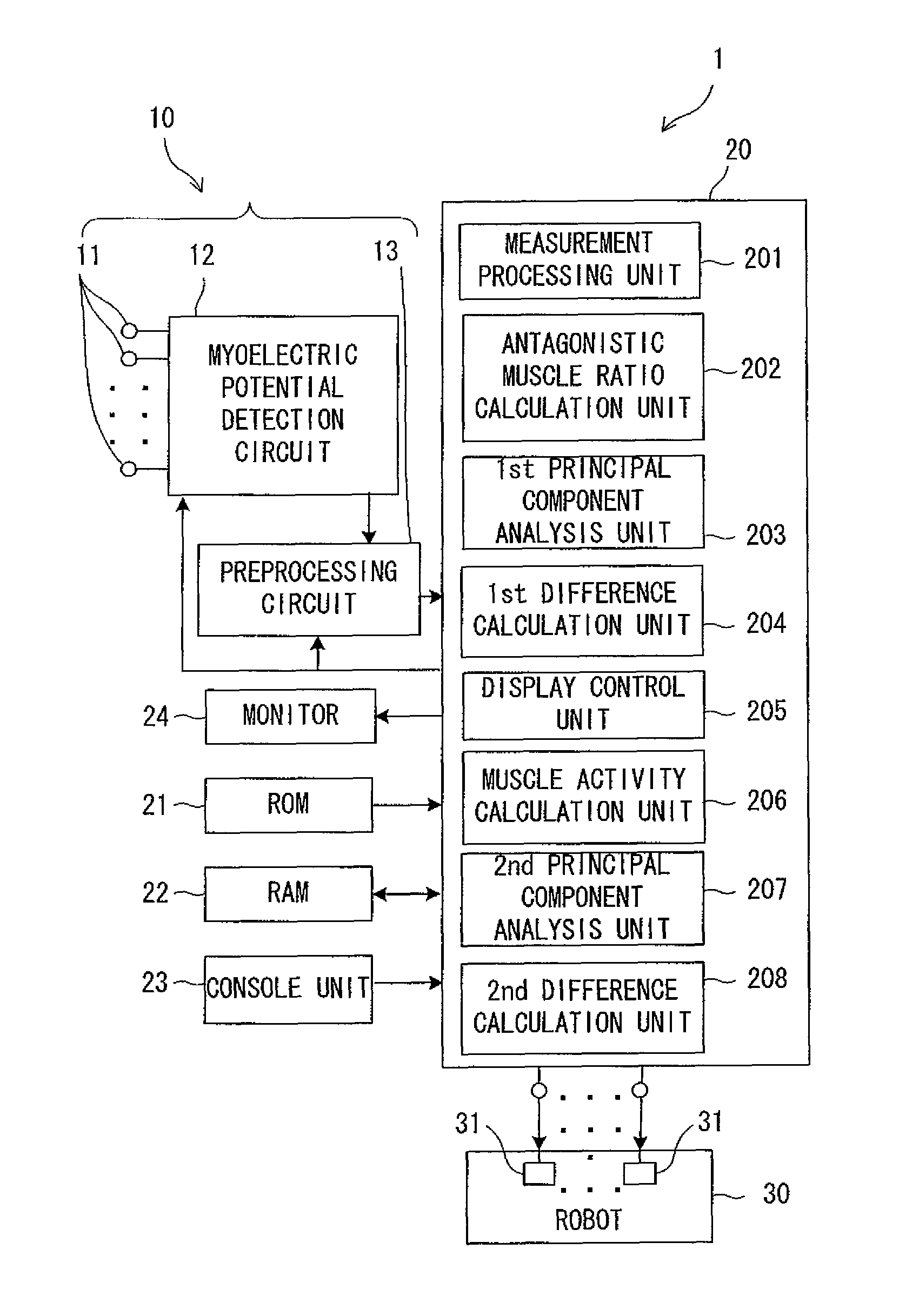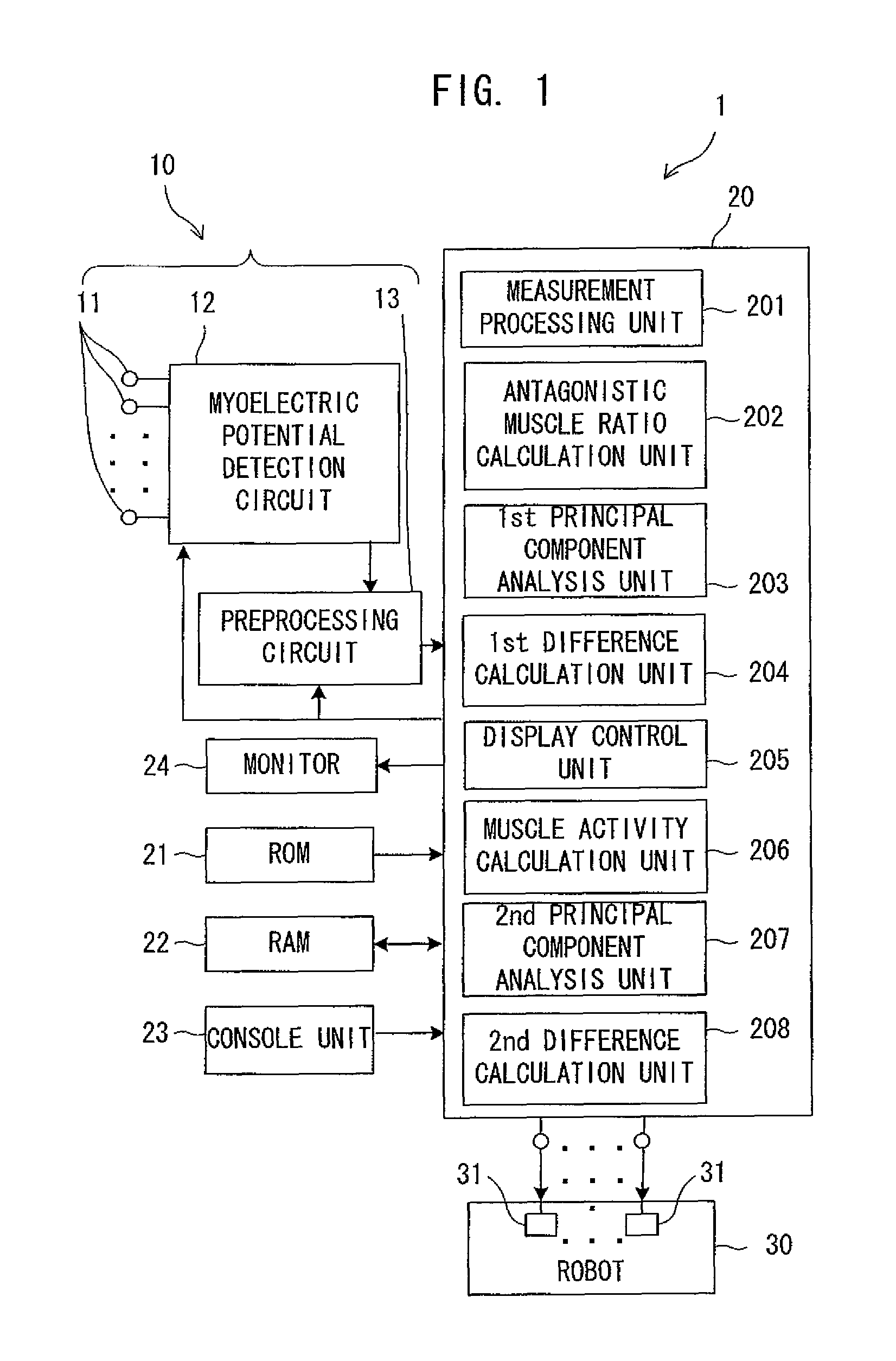Muscle synergy analysis method, muscle synergy analyzer, and muscle synergy interface
a synergy analysis and muscle technology, applied in the field of muscle synergy related techniques, can solve the problems of large scale and high cost, the cost and time necessary for computation cannot be ignored, and the computational cost cannot be ignored to achieve real-time computation, etc., to achieve high correlation, speed up processing, and compact configuration
- Summary
- Abstract
- Description
- Claims
- Application Information
AI Technical Summary
Benefits of technology
Problems solved by technology
Method used
Image
Examples
example experiment 1
[0085]EMG (electromyogram to directly measure muscle action) measurement was performed for a walking motion by a healthy male person as a subject. Muscle coordination was emphasized and the concept of a ratio of antagonistic muscles to be considered a minimal unit of the muscle coordination was introduced, and principal component analysis was conducted using the concept. Thereby, antagonistic muscle ratios of eight muscles were able to be compressed into three patterns. Further, the concept of muscle activity to add actions of antagonistic muscles was introduced, and considering the muscle activity as well as the antagonistic muscle ratio used, the following describes that functions of an antagonistic muscle group plays a very important role for muscle coordination.
experiment method
[0086]In the present research, focusing on the muscle action during walking on a treadmill, eight muscles of the right lower limb of a healthy male person (23 years old, 174.5 cm in height, 48 kg in weight, right-footed) walking at a natural speed were selected and myoelectric potentials thereof were measured (see FIG. 2).
Experiment Equipment
[0087]Myoelectric potentials were measured using surface electrodes of 10 mm in size with the interelectrode distance set at 20 mm. The myoelectric potentials were amplified with a myoelectric potential acquisition device and a bio-amplifier WEB-9000 (produced by Nihon Kohden), and thereafter using an AD converter / recorder LX-110 (produced by TEAC) and an image recorder AQVU (produced by TEAC), a camera image was recorded in a synchronized manner. The camera image data was used for judging a gait phase. The gait phase includes one gait cycle from right-heel contact with the ground to next right-heel contact with the ground, and includes a double...
experiment 2
Experiment Method
[0109]In the present experiment, a healthy male person (22 years old, right-handed) volunteered for a unique task of moving a hand clockwise along a circular trajectory in a plane without a constraint of the hand, and myoelectric potentials, hand positions and joint angles of him were measured (FIG. 10).
[0110]Table 2 shows the names of muscles undergone the myoelectric potential measurement.
[0111]
TABLE 2Muscle numberMuscle No.Muscle namem1deltoid posteriorm2deltoid anteriorm3triceps long headm4bicepsm5triceps latral headm6brachioradialism7flexor carpi radialism8extensor carpi ulnaris
[0112]Table 3 illustrates definitions of parameters and attached points of the muscles.
[0113]
TABLE 3Antagonistic muscle ratio and their functionRatio No.PairFunctionr1m1 / m2Shoulder extentionr2m4 / m3(Shoulder flexion) & Elbow flexionr3m5 / m6Elbow extentionr4m8 / m7(Elbow extention) & Wrist extention
[0114](Experimental Task)
[0115]Initial values of the hand position and the joint angles are as...
PUM
 Login to View More
Login to View More Abstract
Description
Claims
Application Information
 Login to View More
Login to View More - R&D
- Intellectual Property
- Life Sciences
- Materials
- Tech Scout
- Unparalleled Data Quality
- Higher Quality Content
- 60% Fewer Hallucinations
Browse by: Latest US Patents, China's latest patents, Technical Efficacy Thesaurus, Application Domain, Technology Topic, Popular Technical Reports.
© 2025 PatSnap. All rights reserved.Legal|Privacy policy|Modern Slavery Act Transparency Statement|Sitemap|About US| Contact US: help@patsnap.com



